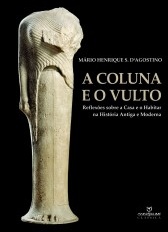A column may be any upright cylinder to carry weight – plain columns are a commonplace of modern building. Too often they are just neutral and impersonal building elements. That is not how Vitruvius treated them two thousand years ago in the oldest surviving manual to architecture. He describes them as articulated into three body-parts: foot, trunk, and head while they are also quite explicitly distinguished into different genders: the robust and male Doric, the slender and virginal Corinthian, and as a median – and therefore the superior – category, the female Ionic. Their variety could be explained and commented in terms of historic and regional origins but above all by the analogue – the varieties of human configuration.
By the time Vitruvius wrote, columns had been part of the building process for centuries, even millennia. And perhaps before they appeared as parts of building structure, standing stones and tree-trunks planted in the ground were seen as analogues of the bodies of the very people who set them up. So that the shadows they cast were signs of human presence and orientation
Mario d'Agostino has unrivaled knowledge of such matters and his essay provides an invaluable commentary to their complexity. And of course, he knows well that in advocating the most shocking idea, that of the house as a machine a habiter, Corbusier – that most radical of architectural thinkers, also found the essential guarantee that the machine he constantly invoked could, for all the lightness it gave building, only assure that harmony which he thought was essential to architecture by invoking the same analogue of the human body that had been so explicit in the articulation of antique columns.
about the author
Joseph Rykwert, art and architecture historian, born in Poland, naturalized British. He studied architecture at the Bartlett School and at the Architectural Association School. Doctor by the Royal College of Art in London, he taught at the universities of Essex and Cambridge. He is currently linked to the University of Pennsylvania.
note
NE – This text was published on the cover of the refered book.



![Amphora showing Orestes before the tomb of Agamemnon, a column topped by a helmet personifying his dead father. Fourth century B.C. [Museo Archeologico Nazionale, Napoli]](https://vitruvius.com.br/media/images/magazines/grid_9/c79247cd4c7b_maique_anfora.jpg)
![Amphora showing Orestes before the tomb of Agamemnon, a column topped by a helmet personifying his dead father. Fourth century B.C. [Museo Archeologico Nazionale, Napoli]](https://vitruvius.com.br/media/images/magazines/gallery_thumb/c79247cd4c7b_maique_anfora.jpg)

